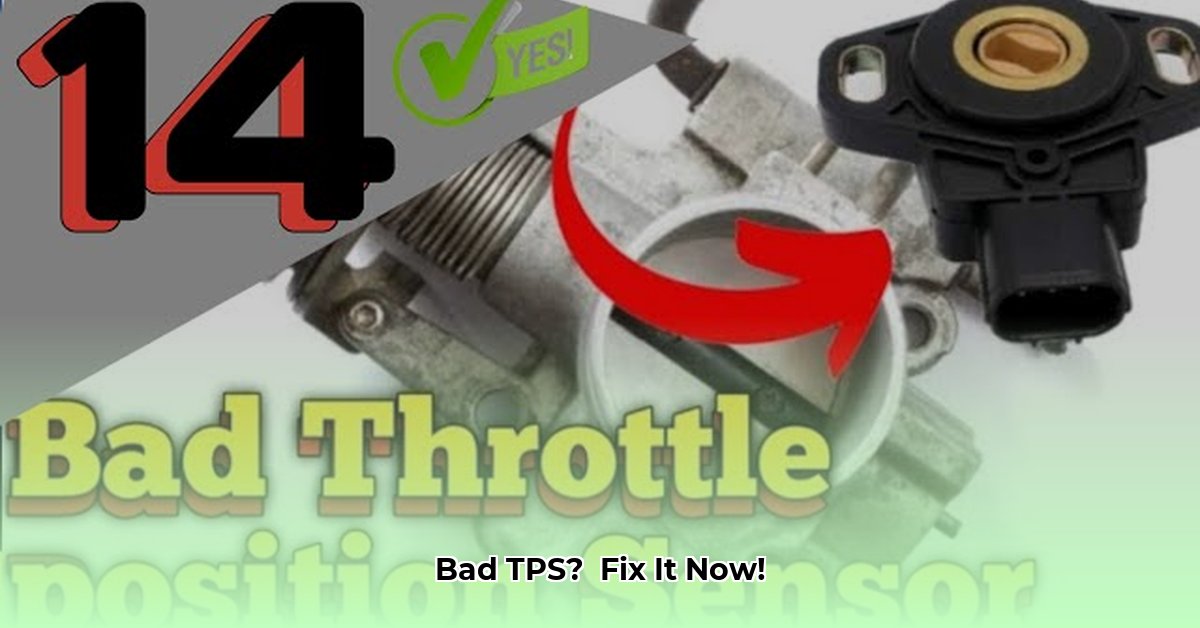Could a Bad TPS Be Causing Your Car Trouble?
Is your car sputtering, hesitating, or suddenly guzzling gas? The culprit might be a small but crucial component: the Throttle Position Sensor (TPS). This comprehensive guide will help you identify, understand, and fix a faulty TPS, even if you’re not a car expert.
Recognizing the Red Flags: Symptoms of a Bad TPS
A malfunctioning TPS can manifest in various ways, impacting your car’s performance and fuel efficiency. Here are some common indicators:
- Illuminated Check Engine Light: This is often the first sign. The car’s computer (ECU) detects a problem with the TPS and triggers the warning light. Using an OBD-II scanner can reveal specific trouble codes (like P0120-P0124) related to the TPS.
- Rough Idle: A faulty TPS can disrupt airflow, leading to a shaky and unstable idle. Your engine might sound like it’s about to stall, especially at a stoplight.
- Unresponsive Gas Pedal: The TPS communicates throttle position to the ECU. A failing sensor can cause hesitation, delayed acceleration, or sudden surges—making your gas pedal feel unresponsive.
- Power Loss: A bad TPS can restrict engine power, making your car feel sluggish, especially during acceleration or uphill climbs.
- Decreased Fuel Economy: A malfunctioning TPS might signal the ECU to deliver excess fuel, resulting in poor gas mileage and more frequent trips to the pump.
- Shifting Problems (Automatic Transmissions): Inconsistent engine performance caused by a faulty TPS can impact gear shifts, leading to harsh, clunky, or delayed shifting, and potentially activating “limp mode” in extreme cases.
- Surging and Hesitation: Jerky acceleration or hesitation when pressing the gas pedal may suggest the TPS is sending inconsistent signals.
- Intermittent Issues: These can be the most frustrating. The problem might appear and disappear, making diagnosis challenging.
Pinpointing the Problem: Testing Your TPS
Suspect a bad TPS? Here’s how to test it:
What You’ll Need:
- Digital Multimeter
- Your Car’s Repair Manual (crucial for specific wiring diagrams)
- Carburetor Cleaner and a Clean Rag (optional, for cleaning the throttle body)
Steps:
- Safety First: Disconnect the negative battery cable.
- Locate the TPS: Consult your repair manual for its precise location on the throttle body.
- Key On, Engine Off: Turn the ignition to the “ON” position without starting the engine.
- Identify the Wires: Using your repair manual, locate the ground, signal, and 5V reference wires on the TPS connector.
- Closed Throttle Voltage Test: Connect the multimeter’s black lead to a good ground and the red lead to the signal wire. With the throttle closed, the reading should be between 0.2 and 1.5 volts (check your manual for specific values).
- Open Throttle Voltage Test: Slowly depress the gas pedal fully. The voltage should increase smoothly to around 5 volts. Erratic jumps or a lack of smooth increase suggest a faulty TPS.
- Resistance Test (Optional): If voltage tests indicate a problem, disconnect the TPS connector. Measure resistance between the signal and ground wires at different throttle positions, comparing your readings to those in your repair manual. Fluctuations or an infinite reading often signals a bad TPS.
Understanding the TPS: Function and Failure
The TPS is a potentiometer that measures the angle of the throttle plate. It translates your gas pedal input into an electrical signal for the ECU, which controls fuel injection. Several factors can cause TPS failure:
- Wear and Tear: Constant movement and vibrations can eventually wear out the sensor.
- Extreme Temperatures: Excessive heat or cold can impact its performance.
- Moisture and Corrosion: Humidity can corrode the sensor and its connections.
- Wiring Issues: Loose or corroded wires can disrupt signal transmission.
- Carbon Buildup: Accumulated carbon on the throttle body can interfere with TPS operation.
Fixing the Issue: Replacement and Prevention
A faulty TPS usually requires replacement. While sometimes cleaning the throttle body can resolve issues caused by carbon buildup, replacement is often necessary. If you’re comfortable working on your car, consult your repair manual for detailed instructions. Otherwise, seek professional assistance. A new TPS typically costs $50-$150, with labor adding another $50-$100.
Keeping Your Car Running Smoothly: Additional Tips
While the exact relationship between throttle body cleaning and TPS health is still under investigation, some mechanics suggest that regular cleaning might prevent TPS problems. Addressing other car issues promptly can also help avoid cascading problems that could affect the TPS. Some research suggests that certain driving habits, like consistently flooring the gas pedal, could potentially contribute to accelerated wear and tear on the TPS. However, more research is needed to confirm this theory.
By understanding how the TPS works, recognizing the symptoms of failure, and knowing how to test it, you can keep your car running efficiently and avoid potential headaches down the road.
- Your Perfect Bento Box Bag For Fresh And Tidy Meals - December 2, 2025
- Korean Meal Prep Made Easy For Delicious Weekday Meals - December 1, 2025
- Korean Food Meal Prep Makes Flavorful Weekday Meals Simple - November 30, 2025










